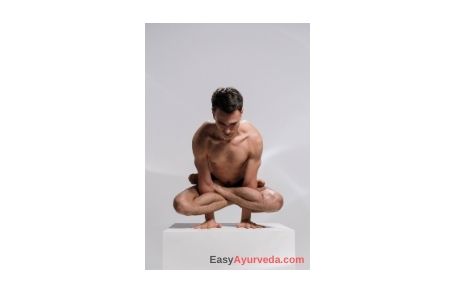Kukkutasana – Cockerel Pose, Right Method, Benefits, Dosha Effects
By Dr Raghuram Y.S. MD (Ay) & Dr Manasa, B.A.M.S
Kukkutasana, is a difficult pose and needs good arm strength to perform the pose. In final pose the practitioner resembles a cock / rooster and hence the name. This pose has been mentioned in Gheranda Samhita and Hatha Yoga Pradeepika. It is an intermediate to advanced pose. It can be done for a time period of 1-5 minutes. It stretches arms and spine. It strengthens wrists, elbows and shoulders.
Read – Hatha Yoga and Shat Karmas: Benefits, Precautions
Table of Contents
Word Meaning
Kukkuta = cock / cockerel
Asana = pose
Other names
- Cock Pose
- Cockerel Pose
- Rooster Pose
Read – Yogasana – Spiritual, Physical And Mental Benefits, Classification

Preparation for Kukkutasana
- One need to do this pose on empty stomach, preferably early in the morning.
- One shall consume food 3-4 hours before doing the pose, especially when the pose is practiced at some other part of the day other than in the morning. This will not only ensure that you one keeps his / her stomach empty by the time of taking on to the pose but also will bestow one with energy needed to perform the pose.
- The bowel and bladder shall be kept empty by the time one takes on to the pose.
Read – Health Benefits Of Yoga: Mind And Body
Method of doing
Positioning for the pose
First sit with crossed legs in Padmasana – lotus pose.
Getting into the pose
Slowly insert your arms in the gap between thighs and calf muscles letting your palms touch the floor. Make sure that fingers are spread out and pointing forwards as they rest on the ground.
Push palms on the floor with as much pressure as you can so as to enable to lift your body in the air.
Slowly raise your body off the floor as you inhale. Now your palms are supporting the entire body weight.
Be in the pose as long as you are comfortable being in and breathe easily.
Release from the pose
- Exhale as you come to the ground.
- Release your hands from between your legs.
- Come back to Padmasana.
- Place your hands on your thighs or hold your fingers in mudra.
- Breathe easily and relax.
- Interchange the position of legs in lotus pose and repeat the steps.
Read – How To Do Pranayama – A Simple Pranayama Technique
Beginner’s tips
Gaze at a predetermined focus and concentrate on it. This will help you gain balance in the pose.
Keep your back erect. Don’t slouch while you are in the pose.
Variations
- Urdhva Kukkutasana
- Parsva Kukkutasana
Related Video
https://www.youtube.com/watch?v=singTLOHD44
https://www.youtube.com/watch?v=s-yUwL1n6cg
https://www.youtube.com/watch?v=NPA93yEpIpQ
Health Benefits
- Makes arm and shoulder muscles strong
- Makes chest broader
- Loosens up legs
- Contracts the perineum and strengthens the muscles therein
- Relieves hip pain
- Stimulates digestive system
- Good remedy for menstrual discomfort
- Builds balance, stability and focus
- Will enable you to become calmer, stronger and happier
Preparatory Poses
- Surya Namaskara – Sun salutation
- Ujjayi Pranayama
- Mula Bandha
- Uddiyana Bandha
Follow Up Poses
- Gupta Padmasana
- Urdhva Padmasana in Sarvangasana
- Sirsasana II
- Urdhva Kukkutasana (with head on the floor)
Time spent in doing Kukkutasana
Hold the pose for 1-3 minutes. The time period can be extended to 4-5 minutes once the flexibility is achieved and after one having mastered the pose.
Impact on Chakras
This pose activates, energizes and regulates Muladhara Chakra. It is also used for awakening the Kundalini energy.
Contraindications
- Heart problems
- Lung problems
- Gastric ulcers
- Enlarged spleen
- High blood pressure
- Back pain
- Hernia
- Prolapse
- Knee injuries
- Weak / injured wrists
- Weak shoulders / elbows
Impact on doshas and tissues
Impact on Doshas and its subtypes – The pose stimulates the digestive system and hence plays a key role in maintaining the balance of the functions of samana vata and pachaka pitta. Its apana vata calming role can be inferred by seeing the role of this pose in curing menstrual discomfort. Since it builds stability, balance and strength and keeps you calm and happier, the pose has balancing effect on not only vata, but also on tridoshas, the tissues of the body and the mental gunas.
Impact on tissues – Since this pose strengthens the muscles it is beneficial for the health of muscles and soft tissues.
Click to Consult Dr Raghuram Y.S. MD (Ayu)









